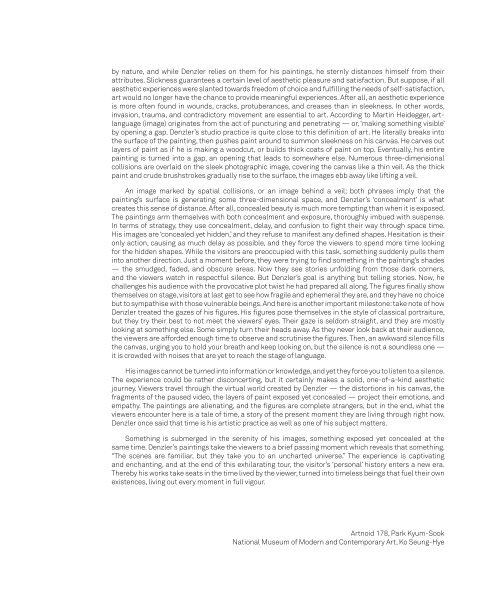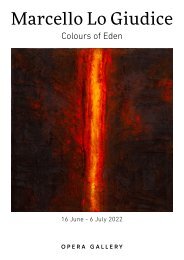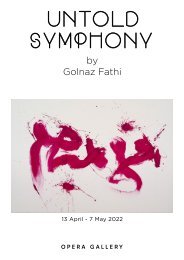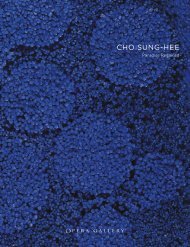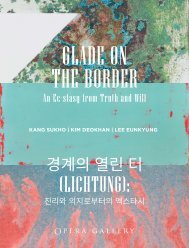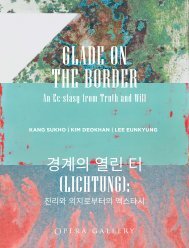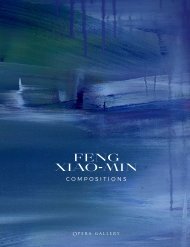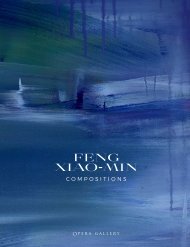ANDY DENZLER. Paintings of Disruption
ANDY DENZLER. Paintings of Disruption Opera Gallery Seoul 8 - 30 November 2019
ANDY DENZLER. Paintings of Disruption
Opera Gallery Seoul
8 - 30 November 2019
You also want an ePaper? Increase the reach of your titles
YUMPU automatically turns print PDFs into web optimized ePapers that Google loves.
y nature, and while Denzler relies on them for his paintings, he sternly distances himself from their<br />
attributes. Slickness guarantees a certain level <strong>of</strong> aesthetic pleasure and satisfaction. But suppose, if all<br />
aesthetic experiences were slanted towards freedom <strong>of</strong> choice and fulfilling the needs <strong>of</strong> self-satisfaction,<br />
art would no longer have the chance to provide meaningful experiences. After all, an aesthetic experience<br />
is more <strong>of</strong>ten found in wounds, cracks, protuberances, and creases than in sleekness. In other words,<br />
invasion, trauma, and contradictory movement are essential to art. According to Martin Heidegger, artlanguage<br />
(image) originates from the act <strong>of</strong> puncturing and penetrating — or, ‘making something visible’<br />
by opening a gap. Denzler’s studio practice is quite close to this definition <strong>of</strong> art. He literally breaks into<br />
the surface <strong>of</strong> the painting, then pushes paint around to summon sleekness on his canvas. He carves out<br />
layers <strong>of</strong> paint as if he is making a woodcut, or builds thick coats <strong>of</strong> paint on top. Eventually, his entire<br />
painting is turned into a gap, an opening that leads to somewhere else. Numerous three-dimensional<br />
collisions are overlaid on the sleek photographic image, covering the canvas like a thin veil. As the thick<br />
paint and crude brushstrokes gradually rise to the surface, the images ebb away like lifting a veil.<br />
An image marked by spatial collisions, or an image behind a veil; both phrases imply that the<br />
painting’s surface is generating some three-dimensional space, and Denzler’s ‘concealment’ is what<br />
creates this sense <strong>of</strong> distance. After all, concealed beauty is much more tempting than when it is exposed.<br />
The paintings arm themselves with both concealment and exposure, thoroughly imbued with suspense.<br />
In terms <strong>of</strong> strategy, they use concealment, delay, and confusion to fight their way through space time.<br />
His images are ‘concealed yet hidden,’ and they refuse to manifest any defined shapes. Hesitation is their<br />
only action, causing as much delay as possible, and they force the viewers to spend more time looking<br />
for the hidden shapes. While the visitors are preoccupied with this task, something suddenly pulls them<br />
into another direction. Just a moment before, they were trying to find something in the painting’s shades<br />
— the smudged, faded, and obscure areas. Now they see stories unfolding from those dark corners,<br />
and the viewers watch in respectful silence. But Denzler’s goal is anything but telling stories. Now, he<br />
challenges his audience with the provocative plot twist he had prepared all along. The figures finally show<br />
themselves on stage, visitors at last get to see how fragile and ephemeral they are, and they have no choice<br />
but to sympathise with those vulnerable beings. And here is another important milestone: take note <strong>of</strong> how<br />
Denzler treated the gazes <strong>of</strong> his figures. His figures pose themselves in the style <strong>of</strong> classical portraiture,<br />
but they try their best to not meet the viewers’ eyes. Their gaze is seldom straight, and they are mostly<br />
looking at something else. Some simply turn their heads away. As they never look back at their audience,<br />
the viewers are afforded enough time to observe and scrutinise the figures. Then, an awkward silence fills<br />
the canvas, urging you to hold your breath and keep looking on, but the silence is not a soundless one —<br />
it is crowded with noises that are yet to reach the stage <strong>of</strong> language.<br />
His images cannot be turned into information or knowledge, and yet they force you to listen to a silence.<br />
The experience could be rather disconcerting, but it certainly makes a solid, one-<strong>of</strong>-a-kind aesthetic<br />
journey. Viewers travel through the virtual world created by Denzler — the distortions in his canvas, the<br />
fragments <strong>of</strong> the paused video, the layers <strong>of</strong> paint exposed yet concealed — project their emotions, and<br />
empathy. The paintings are alienating, and the figures are complete strangers, but in the end, what the<br />
viewers encounter here is a tale <strong>of</strong> time, a story <strong>of</strong> the present moment they are living through right now.<br />
Denzler once said that time is his artistic practice as well as one <strong>of</strong> his subject matters.<br />
Something is submerged in the serenity <strong>of</strong> his images, something exposed yet concealed at the<br />
same time. Denzler’s paintings take the viewers to a brief passing moment which reveals that something.<br />
“The scenes are familiar, but they take you to an uncharted universe.” The experience is captivating<br />
and enchanting, and at the end <strong>of</strong> this exhilarating tour, the visitor’s ‘personal’ history enters a new era.<br />
Thereby his works take seats in the time lived by the viewer, turned into timeless beings that fuel their own<br />
existences, living out every moment in full vigour.<br />
Artnoid 178, Park Kyum-Sook<br />
National Museum <strong>of</strong> Modern and Contemporary Art, Ko Seung-Hye


